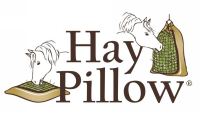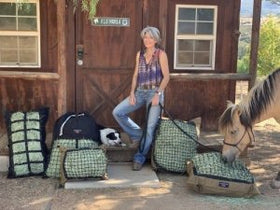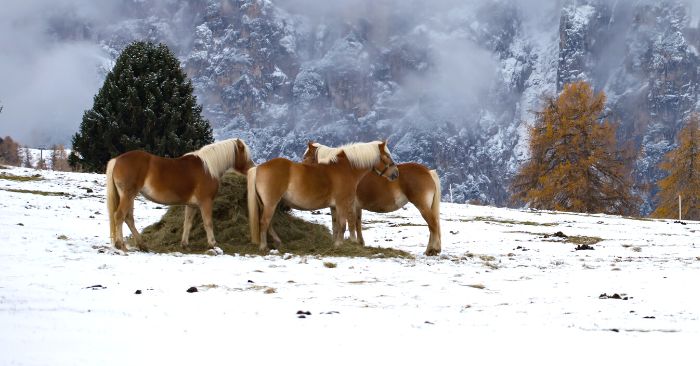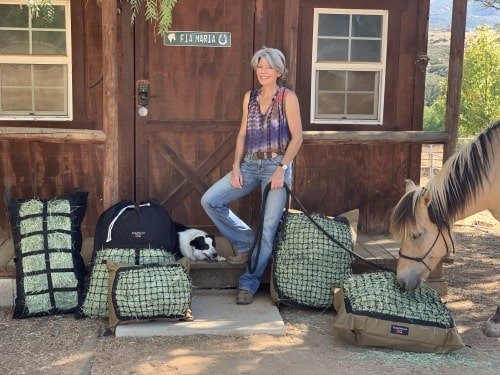Keeping Horses Warm Naturally – Internally and Externally
Read on to learn common misconceptions about the cold and how to stoke internal body heat while providing a healthier, natural lifestyle for your herd.

Misconception #1: Feeding grain & high calorie/starch feeds will keep my horse warm.
Truth: Forage (hay or pasture) provides large amounts of insoluble fiber which is primarily digested in the hindgut (where bacterial fermentation produces internal body heat). High fiber feeds produce long lasting internal body heat to maintain core body temperature. The hindgut is your horse’s furnace! Keeping it stoked with fuel (forage) helps to keep them warm internally.
In contrast, grain and feeds - that are lower in fiber and higher in carbohydrates than forage - are primarily digested in the small intestine. Enzymes are by and large responsible for digestion that occurs there. The small intestine is the main site of soluble carbohydrates, protein and fat digestion as well as vitamin and mineral absorption.
Your horse may require a concentrated source of calories to maintain or gain weight in colder months - but there is minimal internal body heat resulting from digestion (enzymatic) in the small intestine. The increase in body condition score as a result of increased caloric intake eventually provides them with more insulation. Fat can be three times more insulating than other tissues.
Personally, I enjoy offering a big pile of dry shavings outside year around (I live in Southern California). During the winter, it provides a layer of insulation from the cold wet ground and a soft place to lay down in summertime when the ground is dry and hard.
Misconception #2: A hot bran mash will keep my horse warm.
Truth: A warm meal is a short term solution to increase core body temperature. A constant flow of forage provides long term internal body heat. If you don’t feed bran on a daily basis, the introduction of any new feedstuff should be introduced gradually.
Misconception #3: My horse can’t stay warm outside in the cold.
Truth: The horse possesses a highly effective thermoregulation system. Piloerection gives the horse’s hair coat the ability to stand up, lay down and change direction via hair erector muscles trapping warm air and creating an insulating layer. Blanketing prevents this ability and if applied long term can cause hair erector muscles to atrophy. Any muscle can atrophy without exercising for a period of time. Of course, blanketing may be required for a variety of reasons including but not limited to:
- Extreme cold.
- Underweight, older or compromised individuals.
- If appropriate shelter from wind and precipitation is not available.
- Shivering.
If blanketing is required, provide a variety of thicknesses appropriate for the current weather. Be mindful of the fact that they can’t take it off if they get hot or change into a warmer blanket if they get cold and that the entire body heats up or cools down.

Standard Hay Pillow pictured. Shop Slow Feed Hay Bags & Nets.
Stalls can be colder than being outside. The coldest time of day is just before the sun rises and when it does, a stalled horse remains standing - in the shade! Being outside gives them the ability to move and bask in the sun to warm up.
Avoid bathing, which removes the natural oils in their coat that help to protect their skin from getting wet. A healthy diet, parasite control and sufficient healthy omegas produce glowing hair coats; retaining the natural oils on the skin and hair that repel dust and water. Win - win, no need to bathe!
Misconception #4: Winter is the most effective tool for weight loss; restrict forage.
Truth: Addressing the core diet while providing appropriate slow fed free choice forage (via either slow feed hay bags or slow feed bale nets), routine exercise and freedom of movement is the healthiest solution for overweight individuals despite the time of year. Restricting forage for periods of time may rob your horse of the ability to stay warm and comfortable. Being hungry and cold is miserable! Learn how to give your horse more chew time and bulk (without the weight gain).
Gastric ulcers should be a concern whenever forage is restricted for periods of time. The stress associated with the lack of forage, the discomfort of acid build up in the stomach and being cold promotes ulcers and a less than optimum immune system.
Suffice it to say...
By respecting and providing a natural environment, free choice forage (whether slow fed or not) in multiple locations, a warm winter hair coat, concentrated source of calories if needed, appropriate protection from the elements and freedom of movement - you can help your herd cope best with colder temperatures. And you get peace of mind knowing your herd is happy and healthy - while drinking hot tea by the fireplace.
Helpful How To Resources
- Beyond Low Sugar/Starch - Choosing Hay for Weight Management
- Can Horses Eat More Hay Without Weight Gain? The Surprising Factors
- How to Introduce & Incorporate Free-Choice Forage: An Action Plan
- Are You a Prisoner of Feeding? Here's How I Broke Free
- A Safer Always Have Hay Source – Mature Grass Hay
- How & Where to Test Your Horse's Hay & Interpret Results
- Slow Feed Solutions for Any Environment
- Feeding Free Choice - How I Chose the Best Slow Feeder
- Equine Ulcers - 7 Stress Factors & Solutions
- Equine Gastric Acid - 12 Facts You May Not Know
- 9 Benefits of Slow Feeding Horses
- 7 Easy Ways to Help Prevent Colic
- 6 Great Reasons to Feed Your Horse from Ground Level
- Never Exercise Horses on an Empty Stomach...Ever
- Why You Shouldn't Transport Horses on An Empty Stomach
- Why Most Horses Prefer to Eat Outside
References:
- Van Der Veen, J. (August 24, 2015). Fiber Digestion In The Horse. Retrieved from https://www.equisearch.com/discoverhorses/fiber-digestion-horse-29575
- Biggs Waller, S. (November 27, 2016). Equine Internal Combustion. Retrieved from https://thehorse.com/130851/equine-internal-combustion/
- Geor, R. (November 7, 2002). How Horses Digest Feed. Retrieved from https://aaep.org/horsehealth/how-horses-digest-feed
- Hammer, C.(2008). Keep Your Horse Warm This Winter. Retrieved from https://www.ag.ndsu.edu/news/newsreleases/2008/dec-24-2008/keep-your-horse-warm-this-winter
- Thunes, C. (January 15, 2019). How Do Horses Thermoregulate When It Is Cold? Part I. Retrieved from http://summit-equine.com/how-do-horses-thermoregulate-when-it-is-cold-part-i/
- Camp, J. (December 11, 2013). An amazing article on why horses should not be blanketed in winter. Retrieved from https://thesoulofahorse.com/blog/a-amazing-article-on-why-horses-should-not-be-blanketed-in-winter/





